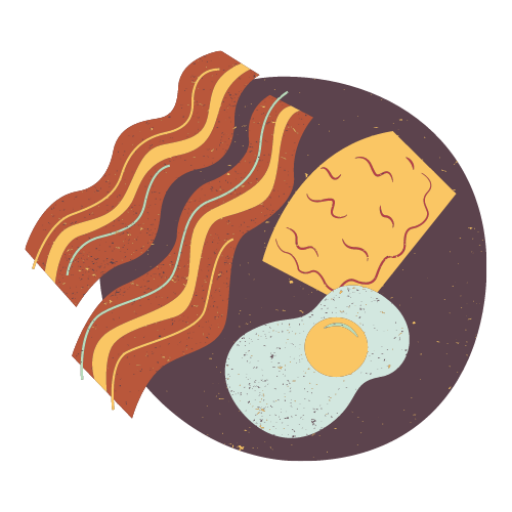Starting your day with a nutritious, blood sugar-friendly breakfast sets the tone for balanced energy levels and overall health. Low glycemic breakfast options can be particularly beneficial for those managing diabetes or looking to maintain steady glucose levels throughout the morning.
Incorporating naturally low glycemic ingredients into breakfast recipes provides a delicious and satisfying way to support metabolic health. These meals often feature complex carbohydrates, lean proteins, and healthy fats, which work together to provide sustained energy without causing rapid spikes in blood sugar. From savory egg dishes to fruity overnight oats, there are numerous tasty options to explore for a healthy morning meal.
1) Avocado Toast on Pumpernickel

Avocado toast on pumpernickel bread offers a low-glycemic breakfast option that combines healthy fats with complex carbohydrates. Pumpernickel bread has a lower glycemic index compared to many other bread types, making it an excellent choice for maintaining stable blood sugar levels.
To prepare this dish, start by toasting a slice of pumpernickel bread until crisp. While the bread toasts, mash half a ripe avocado with a fork, adding a squeeze of fresh lime juice and a pinch of salt to taste.
Spread the mashed avocado evenly on the toasted pumpernickel bread. For added flavor and nutritional benefits, top with sliced cherry tomatoes, a sprinkle of hemp seeds, and a dash of black pepper.
This breakfast provides a good balance of nutrients, including fiber, healthy fats, and vitamins. The combination of avocado and pumpernickel bread helps promote satiety, potentially reducing overall calorie intake throughout the day.
For those seeking extra protein, consider adding a poached egg or a small serving of smoked salmon on top. These additions complement the flavors while maintaining the meal’s low-glycemic profile.
2) Chia Seed Pudding with Almond Milk
Chia seed pudding with almond milk is a simple, nutritious breakfast option that aligns well with a low glycemic diet. This versatile dish requires just a few ingredients and minimal preparation time.
The base recipe combines chia seeds, unsweetened almond milk, and a touch of honey or maple syrup for sweetness. Chia seeds absorb the liquid, creating a pudding-like consistency when left to sit overnight in the refrigerator.
One of the key benefits of this breakfast is its high fiber content. Chia seeds are packed with fiber, which helps slow down the digestion process and prevents rapid spikes in blood sugar levels.
The use of almond milk keeps the dish dairy-free and adds a subtle nutty flavor. Almond milk is naturally low in carbohydrates, making it an excellent choice for those monitoring their glycemic intake.
For added variety, this pudding can be customized with different flavors. A popular option is chocolate chia pudding, made by adding cocoa powder to the mixture. Another variation is vanilla chia pudding, created by incorporating a small amount of vanilla extract.
3) Spinach and Feta Omelette
A spinach and feta omelette provides a nutritious, low-glycemic breakfast option. This dish combines protein-rich eggs with vitamin-packed spinach and tangy feta cheese.
To prepare, whisk eggs with a pinch of salt and pepper. In a skillet, sauté minced onion and garlic until translucent. Add fresh spinach and cook until wilted.
Pour the whisked eggs into the pan, allowing them to spread evenly. As the eggs set, sprinkle crumbled feta cheese over one half of the omelette.
Fold the egg over the cheese and spinach filling. Cook for an additional minute to ensure the cheese melts slightly.
This omelette offers a balance of flavors and textures. The spinach provides fiber and nutrients, while the feta adds a creamy, savory element. The eggs deliver essential proteins and healthy fats.
For added flavor, consider incorporating herbs like dill or oregano. A side of cherry tomatoes or a small serving of whole-grain toast can complement this satisfying breakfast.
4) Greek Yogurt with Walnuts and Berries

Greek yogurt with walnuts and berries is a nutritious, low-glycemic breakfast option that combines protein, healthy fats, and antioxidants. This simple yet satisfying meal can be prepared in minutes and customized to suit individual tastes.
Start with a base of plain, unsweetened Greek yogurt, which provides a creamy texture and high protein content. Greek yogurt is known for its thick consistency and tangy flavor, making it an excellent foundation for a hearty breakfast.
Add a handful of fresh berries such as strawberries, blueberries, or raspberries. These low-glycemic fruits offer natural sweetness and are packed with vitamins and fiber. Their vibrant colors also make the dish visually appealing.
Sprinkle chopped walnuts on top for a crunchy texture and dose of heart-healthy omega-3 fatty acids. Walnuts contribute to the meal’s satiating effect and help stabilize blood sugar levels.
For additional flavor and sweetness, drizzle a small amount of honey over the yogurt. This natural sweetener can be adjusted or omitted based on personal preferences and dietary needs.
5) Whole Grain English Muffin with Peanut Butter
A whole grain English muffin topped with peanut butter offers a nutritious, low glycemic breakfast option. Whole grains provide complex carbohydrates that digest slowly, helping to maintain stable blood sugar levels.
Peanut butter adds healthy fats and protein to the meal. These nutrients further slow digestion and promote satiety. The combination of whole grains and protein makes this breakfast both filling and energizing.
For added nutrition and flavor, consider topping the peanut butter with sliced banana. Bananas provide potassium, vitamin B6, and natural sweetness without spiking blood sugar.
When selecting an English muffin, look for varieties made with 100% whole grains. Check the ingredient list to ensure whole grain flour is listed first. Some brands offer sprouted grain options for potential added digestibility.
Choose natural peanut butter without added sugars or oils for the healthiest option. Crunchy varieties provide extra texture and fiber. A sprinkle of cinnamon can enhance flavor while potentially improving blood sugar control.
6) Quinoa Porridge with Cinnamon
Quinoa porridge with cinnamon offers a nutritious, low-glycemic breakfast option for health-conscious individuals. This warm and comforting dish combines protein-rich quinoa with aromatic cinnamon to create a satisfying morning meal.
To prepare, rinse quinoa thoroughly and cook it in a mixture of water and almond milk. The cooking process typically takes 15-20 minutes, resulting in a creamy consistency similar to traditional oatmeal.
Once cooked, stir in ground cinnamon to taste. The spice not only adds flavor but also helps regulate blood sugar levels. For natural sweetness, consider adding diced apples or a drizzle of maple syrup.
Enhance the nutritional profile by topping the porridge with chopped nuts, seeds, or fresh berries. These additions provide extra fiber, healthy fats, and antioxidants.
Quinoa porridge can be prepared in advance and reheated for busy mornings. It’s also adaptable to slow cooker or pressure cooker methods for convenience.
7) Scrambled Eggs with Tomato and Basil
Scrambled eggs with tomato and basil offer a low-glycemic breakfast option that’s both nutritious and flavorful. This simple dish combines protein-rich eggs with fresh vegetables for a balanced morning meal.
To prepare, start by preheating a skillet and adding a small amount of oil. Sauté chopped tomatoes until they begin to soften, which typically takes a few minutes.
In a separate bowl, whisk eggs with a pinch of salt and pepper. Pour the egg mixture into the skillet with the tomatoes and reduce the heat to medium-low.
As the eggs begin to set, gently fold them with a spatula. This technique creates soft, fluffy curds. Cook until the eggs reach the desired consistency.
Just before serving, fold in fresh basil leaves. The aromatic herb adds a burst of flavor and complements the eggs and tomatoes perfectly.
This versatile dish can be customized with additional low-glycemic ingredients like spinach or mushrooms. Serve alongside whole grain toast or a small portion of fruit for a complete breakfast.
8) Overnight Oats with Chia Seeds
Overnight oats with chia seeds offer a nutritious, low glycemic breakfast option that’s perfect for busy mornings. This no-cook meal combines rolled oats, chia seeds, and milk or yogurt, allowing the ingredients to soak and soften overnight in the refrigerator.
Chia seeds add extra fiber, protein, and omega-3 fatty acids to the dish, enhancing its nutritional profile. The combination of oats and chia seeds creates a slow-release energy source, helping to maintain stable blood sugar levels throughout the morning.
To prepare, mix oats, chia seeds, milk or yogurt, and optional flavorings like cinnamon or vanilla in a container. Refrigerate for at least 8 hours or overnight. In the morning, stir the mixture and add toppings if desired.
Fresh fruits, nuts, or a drizzle of honey can be added for extra flavor and nutrients. The versatility of overnight oats allows for countless variations to suit individual tastes and dietary needs.
This make-ahead breakfast is not only convenient but also easily customizable. It can be eaten cold or warmed up, depending on preference. The creamy texture and satisfying taste make overnight oats with chia seeds a popular choice for a healthy start to the day.
9) Smoked Salmon on Rye Crispbread

Smoked salmon on rye crispbread offers a delicious low-glycemic breakfast option. This simple yet satisfying meal combines protein-rich salmon with fiber-packed rye for a balanced start to the day.
Rye crispbread provides a crunchy base with a lower glycemic impact compared to traditional breads. Its high fiber content helps slow digestion and maintain steady blood sugar levels.
Smoked salmon adds a rich flavor and valuable nutrients. It’s an excellent source of omega-3 fatty acids, which support heart and brain health. The protein in salmon also contributes to feelings of fullness.
To prepare this breakfast, spread a thin layer of cream cheese or avocado on the rye crispbread. Top with slices of smoked salmon and garnish with capers, thinly sliced red onion, or fresh dill if desired.
This quick and easy meal requires no cooking, making it perfect for busy mornings. It can be customized to personal preferences by adjusting toppings or using different types of smoked fish.
10) Cottage Cheese with Pineapple

Cottage cheese with pineapple offers a nutritious, low-glycemic breakfast option. This classic combination provides a balance of protein and natural sweetness.
Cottage cheese is rich in protein, which helps stabilize blood sugar levels. It also contains calcium and other essential nutrients.
Fresh pineapple adds natural sweetness and fiber to the meal. The fruit’s enzymes can aid digestion, while its vitamin C content supports immune function.
To prepare, simply mix cottage cheese with diced fresh pineapple. For added flavor and nutrition, consider sprinkling cinnamon or adding a few chopped nuts.
This quick and easy breakfast can be prepared in minutes. It’s portable, making it suitable for busy mornings or as a healthy snack.
The protein in cottage cheese paired with the fiber in pineapple helps promote satiety. This combination can keep you feeling full and energized throughout the morning.
11) Zucchini Bread with Almond Flour
Zucchini bread made with almond flour offers a low-glycemic alternative to traditional wheat-based recipes. This gluten-free option is naturally moist and nutritious, making it an excellent choice for a healthy breakfast.
Almond flour provides a protein-rich base, contributing to a more balanced blood sugar response. The addition of shredded zucchini adds moisture and fiber, further enhancing the bread’s nutritional profile.
This bread can be customized with various flavors. Some popular additions include cinnamon, nutmeg, or vanilla extract for warmth and depth. For those seeking extra texture, chopped nuts or seeds can be incorporated.
Many recipes for almond flour zucchini bread are free from refined sugars, instead using natural sweeteners like honey or maple syrup in moderation. This approach helps maintain the bread’s low-glycemic status.
The versatility of this bread makes it suitable for different dietary needs. It can be made dairy-free by using plant-based milk alternatives. Some versions are also oil-free, relying on the natural fats in almonds for richness.
12) Eggplant Breakfast Hash

Eggplant breakfast hash offers a low-glycemic alternative to traditional potato-based hashes. This savory dish combines cubed eggplant with other vegetables for a nutrient-rich start to the day.
To prepare, sauté diced eggplant in olive oil until golden and crispy. Add bell peppers, onions, and garlic for flavor and texture. Tomatoes can be included for extra juiciness and vitamins.
Season the hash with herbs like thyme or rosemary. For protein, consider adding scrambled eggs or tofu. This combination creates a filling meal that helps maintain stable blood sugar levels throughout the morning.
Eggplant’s low glycemic index makes it an excellent choice for those monitoring their glucose intake. Its fiber content also aids in digestion and promotes a feeling of fullness.
This versatile dish can be customized with various spices or vegetables to suit different tastes. Serve it hot, garnished with fresh herbs for a satisfying and healthful breakfast option.
13) Buckwheat Pancakes with Blueberries
Buckwheat pancakes offer a nutritious, low glycemic alternative to traditional wheat-based pancakes. Despite its name, buckwheat is not related to wheat and is naturally gluten-free.
These pancakes are made by combining buckwheat flour with basic ingredients like eggs, milk, and a small amount of sweetener. Baking powder helps create a light, fluffy texture.
Adding fresh blueberries to the batter or on top of the cooking pancakes provides natural sweetness and a burst of antioxidants. Blueberries are low on the glycemic index, making them an ideal complement to buckwheat.
To prepare, mix the dry ingredients in one bowl and the wet ingredients in another. Combine them gently, being careful not to overmix. Cook the batter on a hot, lightly oiled griddle or skillet.
For extra flavor and nutrition, consider adding cinnamon or nutmeg to the batter. Serve the pancakes with additional fresh blueberries or a small amount of pure maple syrup for a delicious, low glycemic breakfast option.
14) Vegetable Frittata with Asparagus

A vegetable frittata with asparagus offers a low glycemic breakfast option packed with nutrients. This dish combines eggs, asparagus, and other vegetables for a satisfying morning meal.
To prepare, start by whisking eggs in a bowl with a pinch of salt and pepper. Chop asparagus into bite-sized pieces and sauté briefly in a skillet with olive oil.
Add other vegetables like diced bell peppers, spinach, or mushrooms to the skillet for extra flavor and nutrition. Pour the whisked eggs over the vegetables and cook on low heat until the edges set.
Finish the frittata under the broiler for a few minutes to ensure the top is golden and fully cooked. This method creates a light, fluffy texture throughout the dish.
Frittatas are versatile and can be customized with various low glycemic vegetables. The combination of protein from eggs and fiber from vegetables helps maintain stable blood sugar levels.
Serve the frittata hot, sliced into wedges. It can be enjoyed on its own or paired with a side of mixed greens for a complete, balanced breakfast.
15) Almond Flour Banana Bread
Almond flour banana bread offers a low-glycemic alternative to traditional recipes. This healthier version uses almond flour instead of wheat flour, reducing the carbohydrate content.
The recipe typically combines mashed ripe bananas, almond flour, eggs, and a small amount of sweetener. Cinnamon, baking soda, and salt are common additions for flavor and leavening.
Preparation involves mixing the wet and dry ingredients separately, then combining them to form a batter. The mixture is poured into a greased or parchment-lined loaf pan.
Baking temperatures range from 325°F to 350°F (163°C to 177°C). The bread usually bakes for 50 to 55 minutes, with some recipes suggesting covering the loaf partway through to prevent over-browning.
Optional ingredients like flaxseed meal can boost the nutritional profile. Some versions include chocolate chips or nuts for added texture and flavor.
This bread provides a satisfying breakfast option that’s lower in carbs and higher in protein and healthy fats compared to conventional banana bread. It’s suitable for those following low-carb or gluten-free diets.
Understanding Low Glycemic Foods
The glycemic index measures how quickly foods raise blood sugar levels. Low glycemic foods digest slowly, providing steady energy and helping manage blood sugar.
What is the Glycemic Index?
The glycemic index (GI) ranks carbohydrate-containing foods on a scale from 0 to 100 based on how they affect blood glucose. Foods with a GI of 55 or less are considered low glycemic. Medium GI foods range from 56-69, while high GI foods are 70 or above.
Low GI foods include most fruits, non-starchy vegetables, legumes, and whole grains. These foods cause a gradual, low rise in blood sugar.
High GI foods like white bread, sugary cereals, and processed snacks trigger rapid spikes in blood glucose levels. The GI can vary based on factors like ripeness, cooking method, and food combinations.
Benefits of Low Glycemic Breakfasts
Low glycemic breakfasts offer several health advantages. They provide sustained energy throughout the morning, helping avoid mid-morning energy crashes.
These meals promote better appetite control and can aid in weight management. The steady glucose release keeps people feeling full for longer periods.
Low GI breakfasts may improve concentration and mental performance. They help maintain stable blood sugar, supporting cognitive function.
For those with diabetes or prediabetes, low glycemic morning meals assist with blood sugar management. They reduce the risk of blood glucose spikes and support overall glycemic control.
Nutritional Components of a Low Glycemic Breakfast

A well-balanced low glycemic breakfast contains key nutrients that help stabilize blood sugar and provide sustained energy. Fiber and protein play crucial roles in creating a nutritious morning meal that supports overall health and wellness.
Role of Fiber
Fiber is essential in low glycemic breakfasts. It slows digestion, preventing rapid blood sugar spikes. Soluble fiber forms a gel-like substance in the digestive tract, further delaying glucose absorption.
Good sources of fiber for breakfast include:
- Oats
- Berries
- Chia seeds
- Flaxseeds
- Whole grain bread
Aim for 5-10 grams of fiber in your morning meal. This amount helps promote fullness and improves digestive health. Combining fiber-rich foods with protein creates a satisfying breakfast that keeps you energized until lunch.
Importance of Protein
Protein is a vital component of low glycemic breakfasts. It increases satiety, helping control appetite throughout the day. Protein also slows the absorption of carbohydrates, contributing to more stable blood sugar levels.
Excellent protein sources for breakfast include:
- Eggs
- Greek yogurt
- Cottage cheese
- Nuts and seeds
- Lean meats
Including 15-20 grams of protein in your breakfast can significantly impact blood sugar management. This amount supports muscle health and provides the building blocks for various bodily functions. Pairing protein with complex carbohydrates and healthy fats creates a well-rounded, low glycemic morning meal.




